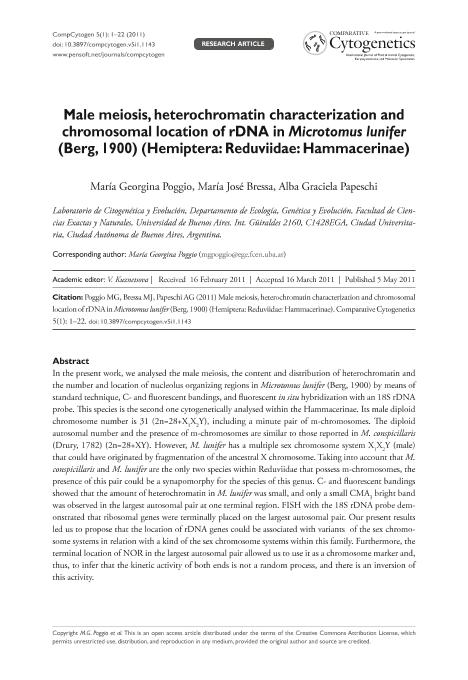Artículo
Male meiosis, heterochromatin characterization and chromosomal location of rDNA in Microtomus lunifer (Berg, 1900) (Hemiptera: Reduviidae: Hammacerinae)
Fecha de publicación:
05/2011
Editorial:
Pensoft Publishers
Revista:
Comparative Cytogenetics
ISSN:
1993-078X
Idioma:
Inglés
Tipo de recurso:
Artículo publicado
Clasificación temática:
Resumen
In the present work, we analysed the male meiosis, the content and distribution of heterochromatin and the number and location of nucleolus organizing regions in Microtomus lunifer (Berg, 1900) by means of standard technique, C- and fluorescent bandings, and fluorescent in situ hybridization with an 18S rDNA probe. This species is the second one cytogenetically analysed within the Hammacerinae. Its male diploid chromosome number is 31 (2n=28+X 1X 2Y), including a minute pair of m-chromosomes. The diploid autosomal number and the presence of m-chromosomes are similar to those reported in M. conspicillaris (Drury, 1782) (2n=28+XY). However, M. lunifer has a multiple sex chromosome system X 1X 2Y (male) that could have originated by fragmentation of the ancestral X chromosome. Taking into account that M. conspicillaris and M. lunifer are the only two species within Reduviidae that possess m-chromosomes, the presence of this pair could be a synapomorphy for the species of this genus. C- and fluorescent bandings showed that the amount of heterochromatin in M. lunifer was small, and only a small CMA 3 bright band was observed in the largest autosomal pair at one terminal region. FISH with the 18S rDNA probe demonstrated that ribosomal genes were terminally placed on the largest autosomal pair. Our present results led us to propose that the location of rDNA genes could be associated with variants of the sex chromosome systems in relation with a kind of the sex chromosome systems within this family. Furthermore, the terminal location of NOR in the largest autosomal pair allowed us to use it as a chromosome marker and, thus, to infer that the kinetic activity of both ends is not a random process, and there is an inversion of this activity.
Archivos asociados
Licencia
Identificadores
Colecciones
Articulos(IEGEBA)
Articulos de INSTITUTO DE ECOLOGIA, GENETICA Y EVOLUCION DE BS. AS
Articulos de INSTITUTO DE ECOLOGIA, GENETICA Y EVOLUCION DE BS. AS
Citación
Poggio, María Georgina; Bressa, Maria Jose; Papeschi, Alba Graciela; Male meiosis, heterochromatin characterization and chromosomal location of rDNA in Microtomus lunifer (Berg, 1900) (Hemiptera: Reduviidae: Hammacerinae); Pensoft Publishers; Comparative Cytogenetics; 5; 1; 5-2011; 1-22
Compartir
Altmétricas




